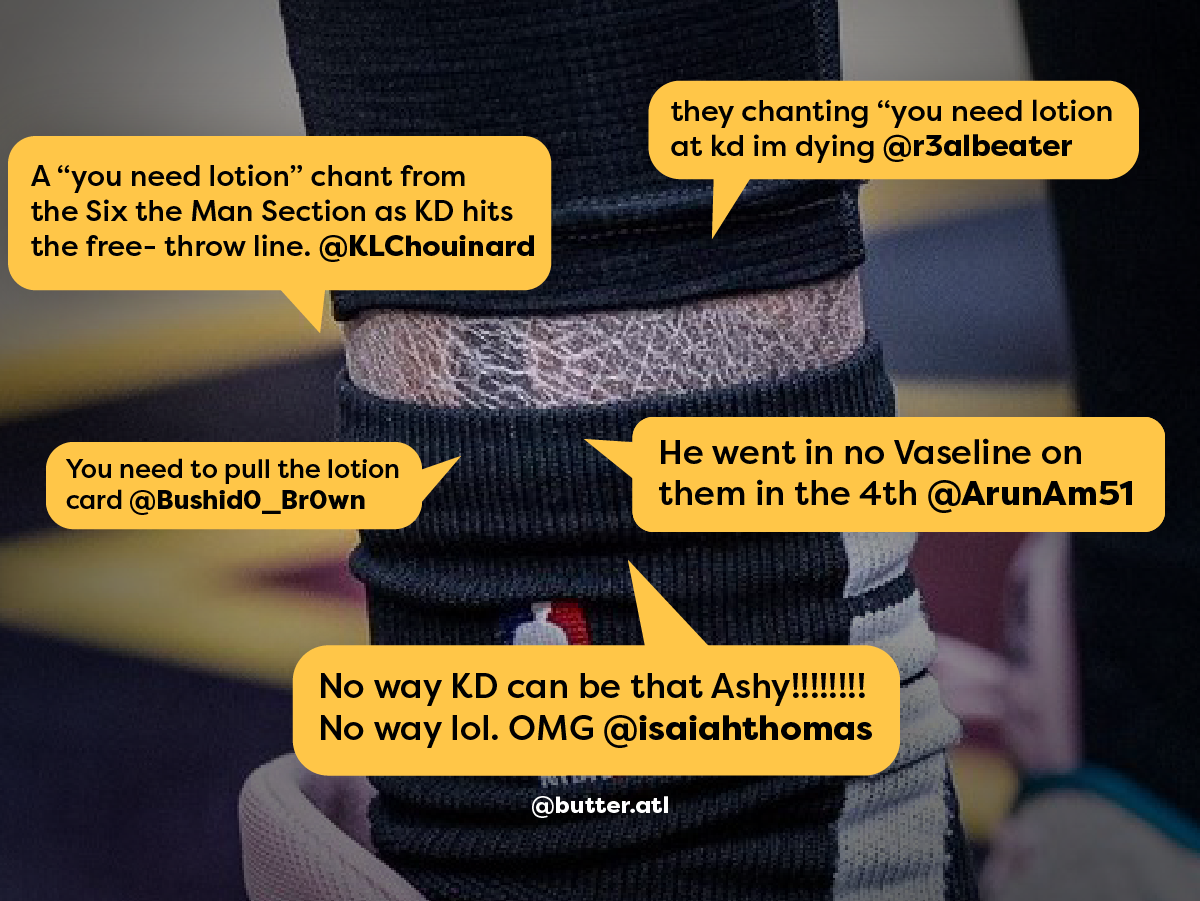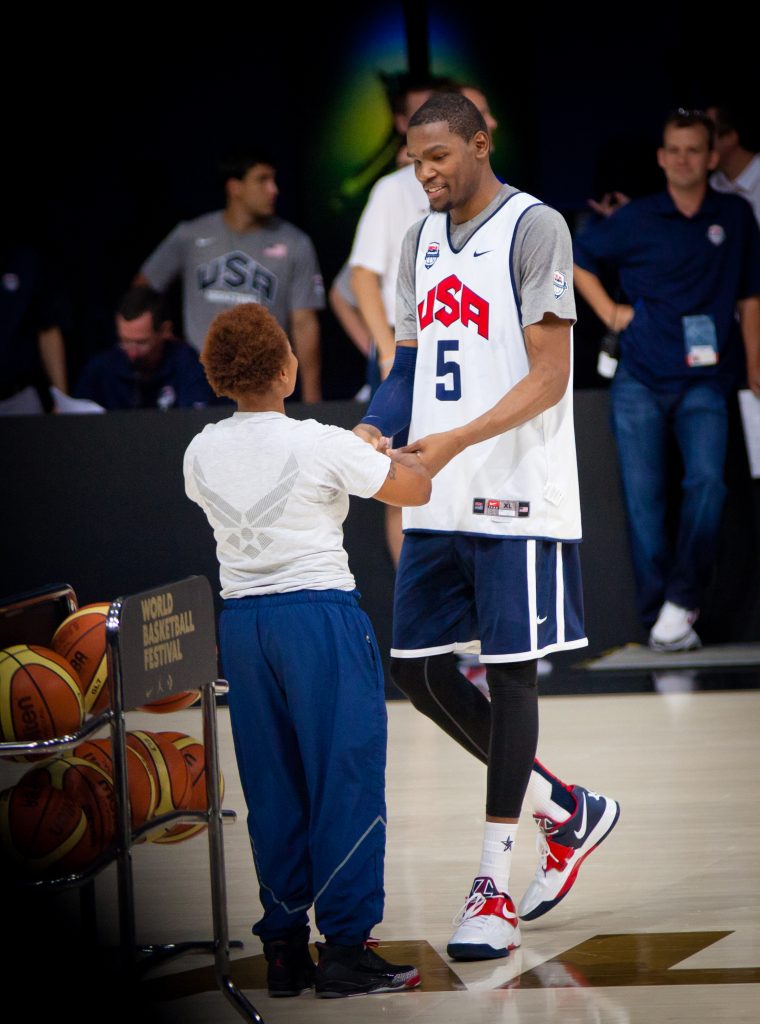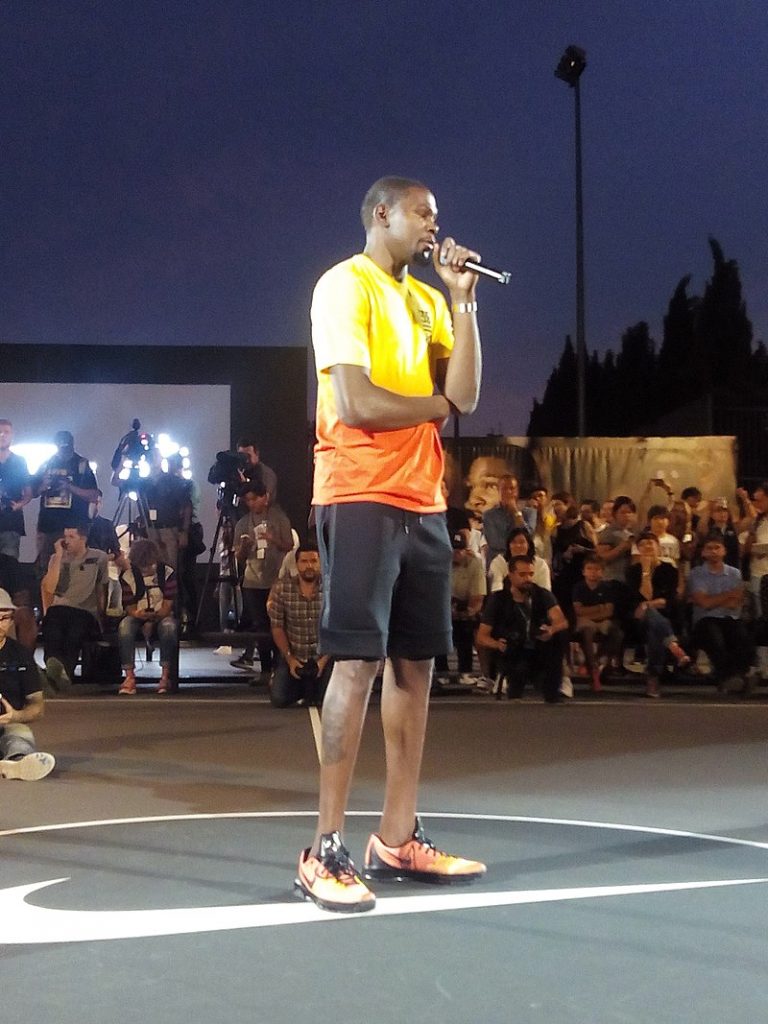The Churn
SKIN IN THE GAME: An Atlanta Dermatologist Weighs In on Hawks Fans Heckling Kevin Durant’s Dry Skin Last Week
Mike JordanDecember 16, 2021

Kevin Durant was heckled at the free throw line while playing the Atlanta Hawks this past Friday at the State Farm Arena, according to Twitter. The chant coming from the crowd wasn’t “airball” — that’d just be delusional. It wasn’t some anti-Brooklyn city hate, because in recent times, when Atlanta aims competitive salt at New York City, it’s at the Knicks, who we thrashed and trashed, appropriately.
This was about Durant’s skin. Specifically, fans in Atlanta were yelling “You need lotion” at Kevin Durant.
The Nets beat us that night, 113-105. Durant scored 31 to secure the W, and even bullied Trae Young a little bit. But Atlanta, the “city too busy to hate,” showed that we can be just as much of a bully, though not quite in the friendly, sportsmanlike kinda way.
A few weeks ago, SLAM Kicks posted a series of photos of Kevin Durant from the Nets vs. Cavaliers game. It’s easy to assume that the close-up of Durant’s lower leg and foot were to get a good look at his sneakers, since Slam Kicks is the sneaker arm of the basketball publication. But in an apparent attempt to zoom in on the shoes, the camera inadvertently got a high-definition glance at something else, through a thin gap between his pant leggings and his high-pulled socks where his skin was visible: Durant’s very dry lower leg.
The jokes began flying immediately. They came from everywhere — basic social media fans, sports journalists, and even bonafide celebrity athletes.
Durant even replied to the jokes, in a way that sort of said to me that he didn’t find the jokes funny. That didn’t stop the slime.
I didn’t really need to zoom in on the photo to understand what was going on, because I could personally relate. The immediate thought that came to my mind was, “They don’t know.”
It’s not just because I think Kevin Durant is cool that I find myself feeling empathy for him. It goes back to the story of how I developed spogiotic dermatitis, or eczema.
One boring weekday afternoon in 2012 I was washing the dishes in my sink, and placed a just-cleaned pint glass on the edge of the kitchen counter with intention to place it in the cabinet. Moving around too much and not paying attention, I accidentally bumped into it, and before I knew it, the pint glass had fallen to the ground. It landed hard, split diagonally from the base upward, and the heaviest piece bounced back up with just enough speed and momentum to slice the back of my leg open, through my jeans.
I’ll never forget the lack of pain, but knowing that I was cut deeply right after a very slight sensation of something scratching me. I reached back and felt the jeans on the back of my calf getting wetter. I rolled up my pants leg, and sure enough, I could see about a centimeter of what they call “white meat” on the part of my back leg, between the back of my knee and my ankle. I definitely needed stitches.
I drove around the corner to a hospital on Atlanta’s southside, with a torn t-shirt tied tightly around my leg to put pressure on the lacerated area. I received stitches that didn’t hold, which meant the scar didn’t heal correctly. I went to a different hospital to receive a second set of stitches, but the damage was done. Since then I’ve had a scar that’s about an inch wide and maybe 3 inches long, which didn’t want to heal properly after the problem with stitching it up. And not long after, I started to experience a rash on my lower leg.
It’s not uncommon for skin trauma to result in eczema. According to a 1988 report from the National Institute of Health, “Cutaneous trauma may precipitate eczema,” and “the trauma is sufficient to cause obvious tissue damage accompanied by an inflammatory or regenerative response” such as eczema. This usually begins within a few weeks of acute injury at the site of the cutaneous trauma.
Before the scar, and before a doctor diagnosed me with spongiotic dermatitis, I used to love wearing cargo shorts and t-shirts; that was my daily uniform, and because Atlanta has generally mild weather and my work requires me to literally be all over the place, it worked for efficiency. But aside from when I’m on a private beach vacation with my family, I can probably count on both hands and feet — all of which now show signs of eczema — the number of times I’ve worn shorts without tall socks to cover up my leg scar, and admittedly, the marks still on my lower leg from having scratched the shit out of very itchy patches of skin for the last couple years.
I consider myself someone with thick skin when it comes to jokes, mainly from remembering how so many of my friends in middle school turned into complete assholes for no reason, similar to the way people you think are cool show themselves to be assholes on Twitter. But I’m also someone whose literal thick skin on my leg has made me admittedly self-conscious. It’s not so much that I’m personally ashamed of how my leg looks — my ego is strong enough that it barely bothers me, although it would be nice to not have the skin condition or scars.
In case you haven’t noticed, KD has been wearing long leggings under his basketball shorts for a while now, or at least long socks.

FWIW, there is a shot of him that’s credited as being taken in 2015 in Madrid, and he’s wearing neither, with no visible lesions.

And that photo doesn’t show the skin discoloration around his knees, which is visible in this shot of him playing against James Harden back during the lockout season of 2011, so it’s hard to tell what’s going on.

I can’t say for sure whether or not Kevin Durant’s habit of cover his legs and ankles is related to a skin condition, because I’ve neither confirmed that he has one, nor do I know how he sees such a condition if that does turn out to be the case. And I don’t really want to be gawking at Kevin Durant’s legs all day, trying to make an educated guess as to what the case may be.
Obviously I can’t say for sure why KD wears long leggings and socks; I can only speak for myself and speculate. And I just wear the socks and cover up the scars because I know folks are judgmental assholes, even when they don’t realize it.
But KD’s situation — and the fact that even in Atlanta we weren’t above being faultfinding, hypercritical jerks about skin and appearance — made me want to ask someone who might have a better idea. So I reached out to Dr. Darren Casey, dermatologist and dermatologic surgeon at Atlanta Dermatology, who put it all into medical, and perhaps societal, perspective.
You’ve seen the photo of Kevin Durant’s leg. In your opinion, is this something related to lotion?
So it looks like he has what’s called ichthyosis vulgaris. It’s a genetic predisposition that’s autosomal dominance. And so it causes you to have super-dry skin, cracked heels, lots of lines in the palms and soles. You have to use almost prescription-strength moisturizers to make the skin look more normal. But it’s definitely beyond just dry skin; it has nothing to do with lack of moisturizing. I mean, he could have put, you know, regular moisturizers on, or even like olive oil or coconut oil on his skin, and an hour or two later it would look like that again.
It’s not his lack of trying to moisturize. What people like that need is a moisturizer with something like salicylic acid or lactic acid to actually dissolve the flakes. Because when the skin gets dry, it overgrows; it’ll grow, like, 20 times the normal rate. So it makes these thick, almost like goldfish-like scales. So basically, in a way, everybody’s making fun of this guy with a genetic condition.
It’s not about neglect at all. He’s probably putting on lotion. But unless he has a dermatologist he doesn’t know what to do unless he’s thought about it.
He may be self-conscious, because I mean, realistically, a lay person is gonna put blame on him, like “Put some damn moisturizer on,” you know. And it’s definitely blaming the victim. It happens to people with eczema or psoriasis; people think they have an infection sometimes and don’t want to touch them, want to stay away from them. And, you know, this is a genetic condition. It’s the way he was made.
Do you think they’re aware that they’re pointing out something as private and personal as that skin condition, and as something that’s inbound for jokes, because I get it, athlete, opposing team… Do you think people are even aware? What level of awareness do you think they have?
I think they have none. They totally think he’s just a lazy guy who’s not putting on moisturizer. They’re not aware that that condition exists. It’s really very much like blaming someone with eczema or psoriasis, or vitiligo for the condition. People have an awareness of vitiligo. You see someone that has those light spots on their skin. They know it’s not something catchy, it’s not something they’ve done. There are some models who have gone out there and said, “All skin is beautiful;” a couple of very famous models with this very dark and light skin because they have vitiligo. But there’s not probably an awareness of his condition, because it’s not talked about.
Why is it not talked about? Why do you think that there’s not this awareness? Because there’s so much on the web, and so much new information is free and available to us…
I think because this condition can kind of pass for dry skin, so people feel they can, you know, start to chant, to blame. It’s very easy to join on the hate wagon, you know. Everybody’s being trolls, instead of taking a step back and realizing that he’s probably suffered from this since puberty. He probably had his mother yell at him, probably had his grandmother yell at him.
And he doesn’t know anything — he probably doesn’t know he has a condition. He’s just self-blaming, like “I’m putting it on; why is it not working?”
I guess he probably wears the leggings all the time out of shame. He’s trying to hide his legs. He’s self-conscious about them. Some powerful people are still hiding things, still self-conscious about things.
Assuming you have African American patients, does there seem to be any sort of stigma that comes along with that in any way? Have you seen any difference with Black patients?
With Black patients or mixed-race patients, culturally, there’s a discussion of ashy skin. It’s commonly kind of discussed and seen as a negative. You don’t want ashy skin. You’ve got to moisturize your skin. If you don’t take care of yourself, you’re going to be ashy. And this condition will get caught up in that, because it’s not about lack of moisturizing. I mean, unless he has the right prescription medicines and uses them probably at least twice a day, he’s always gonna show this way. People just see it as an exaggeration of what they might see in their own skin. The average person would never get this amount of cracking — this amount of almost-fish-like scale. It’s autosomal dominance.

A lot of people with this condition, and definitely people of color, have a relief when they find out it’s not something bad they’re doing, that they have a name for it. I don’t think there’s an awareness in white or Black lay people that this exists. It’s just not a common-enough condition. There is no support group, you know? And, I mean, it’s an example of, you know, don’t throw stones. I mean, don’t be mean. Because you never know who you’re hurting out there. This is not a lazy guy. This is a guy who has a real skin condition.
Yeah, we know he’s not a lazy guy — he’s literally been the MVP of the NBA…
I mean, if he can train that well, he knows how to take care of things. I’ve had patients that have skin that looks like that, or even thicker, and with the right treatment you can normalize their skin. Now, that being said, if his prescription runs out, then within about two weeks it goes back to looking like that. So it’s beyond dry skin. It’s a skin condition not that different than vitiligo, than eczema, which is spongiotic dermatitis, than psoriasis. And this whole group of trolls, including Serena, are, you know, blaming the victim.
Ever since the pandemic, there’s a large increase in both the numbers and the severity of skin conditions. A lot of skin conditions are made worse from stress, and stress is felt medically. We’re getting vaccines, we’re having our noses swabbed, we’re worried what if we turn positive, we’re worried about our families and friends. And that stress kind of flares all these conditions.
Stress affects our immune system and that drives lots of these conditions. People that have had COVID, about 30 percent experienced hair loss. And that’s a that’s a new thing. I mean, think about it: 30% of people who had it, they’re gonna have thinning of the hair — significant — and that needs treatment to reverse it. So there’s lots of things that, from either medically getting ill or just being afraid of getting ill, that flare skin conditions.
Wow. Okay.
During the pandemic, when the closedown was happening, they said approximately 30 percent of Americans were actually diagnoseable as having either or anxiety or depression, according to psychiatrists. That’s a huge number. Instead of, you know, two percent of the population, 30 percent. A third of people are suffering from clinical medical illness.
So what would you say to people in the sense of your advice to the crowd, and to those folks who are in the social media mob? What would you say to them?
You know, before you cast blame on any individual for their physical differences, realize that that theme of hatred can be turned on you. It’s like, we talk about ageism, weightism, colorism. If you want to mock people because their skin’s too dark, because they’re too fat, I mean, it’s all another type of hatred — judging people based on their appearance. I think the reason happened, if you’re asking me about the psychology, is because this is something that can be seen as being lazy. Culturally, this condition gets lost within that, and not everyone who has dry skin is lazy about moisturizing. Some people have a real medical condition.
As much trouble as America has dealing with its own dreadful past when it comes to skin, you’d think we’d avoid piling on when a Black man — or any person — is being attacked about the appearance of his epidermis. The simple fact that we can’t get over the complexities of complexion should be enough to keep people from being assholes. But again, this is America, and this is America on social media, with the backdrop of athletes being heckled with more and more vile insults.
Atlanta should certainly know better. Dr. King, our native son, told us decades ago that it’s the content of a person’s character, rather than how his or her skin looks, that should be the true measurement of who they are and how they should be judged.
“It’s very easy to join on the hate wagon, you know.”
Dr. Darren casey
Is it self-hate? Is it bullying? Is it projecting? Those are questions we have to ask ourselves next time we feel the urge to insult someone for something over which they had no power, and should feel no shame for in the first place.
Maybe it’s just more evidence that being comfortable in your own skin will never be easy in this country. Either way, that doesn’t mean we shouldn’t try.

